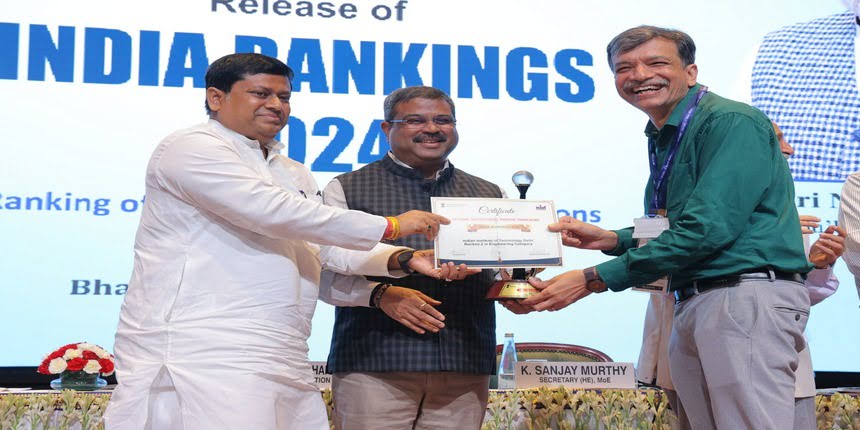NIRF 2024: IITs wrote 24% of all research publications, over 55% MBA institutes had none
Shradha Chettri | August 13, 2024 | 05:10 PM IST | 4 mins read
The NIRF 2024 ranking analysis revealed that only the top 100 institutions were contributing significantly in terms of publications, patents, faculty-student ratio and other parameters.

NEW DELHI: An analysis of data submitted for the National Institutional Ranking Framework (NIRF) 2024 revealed that about 435 of 779 (55.84%) participating management institutions, and 443 colleges of the 1,596 applicants (27.76%), had zero research publications. At the other end of this hugely varied spectrum, the premier engineering colleges, the 16 Indian Institutes of Technology (IIT) ranked, have contributed close to a quarter of all research publications.
The analysis is part of the ranking booklet released by the ministry of education, and shows that only the top 100 institutions ranked are contributing significantly, whether it is in terms of publications, patents, faculty-student ratio or other parameters on which the NIRF is based.
But even among these, there are lacunae. Even at the top institutions ranked in the “overall” category, less than 1% students were from outside the country, highlighting Indian higher education’s continued struggle to attract foreign students.
This year, a total of 10,845 institutions participated in 16 categories. Almost 36% of the participating institutions were from the southern part of India, 30% were from north, 18% from the west and 15% were from the eastern part of the country.
NIRF Ranking 2024: Methodology, parameters
The NIRF framework outlines a methodology to rank institutions across the country which draws, from the overall recommendations, a broad understanding arrived at by a core committee set up by the MHRD. It was approved and launched on September 29, 2015, and this year was its ninth edition.
The parameters broadly cover the following:
Teaching, learning and resources
Research and professional practices
Graduation outcomes
Outreach and inclusivity
Perception
The “teaching, learning and resources” section includes student strength, faculty-student ratio, faculty with PhD, financial resources, online education, multiple entry and exit, Indian knowledge systems and regional languages.
The research and professional practices include publications, citations, patents, research projects and publication and citations in sustainable development goals (SDGs). The graduation outcome entails placement and higher studies, median salary, PhD students.
The “outreach and inclusivity” part looks at regional and gender diversity, economically and socially-challenged students and physically-challenged students. Perception has further two sub parameters – academic peer perception and peers and employers.
Also read NIRF Ranking 2024: Three new categories introduced; IGNOU best open university
Teaching and Learning Resources
Out of the total 2.83 lakh faculty of all the participating institutions, while 1.66 lakh (58.6%) had a PhD degree, 1.17 lakh (41.34%) had a master’s degree.
“It was observed that faculty with doctoral qualification is concentrated in top 100 institutions, while the remaining institutions have fewer faculty with doctoral degrees. This is a serious handicap since mentorship received during the doctoral training as teaching assistant can play a vital role in preparing the faculty for a teaching career in higher education,” stated the analysis report.
Number of faculty members with PhD in top 100 institutions varies from a minimum of 62.98% in case of college category to the maximum of 93.45% in case of management institutions.
In terms of faculty-student ratio (FSR) in the overall category, 537 institutions (39.08%) have FSR of 1:20. There are just about 47 (3.42%) institutions with a faculty student ratio of 1:10. There were a total of 1,374 institutions in the overall category.
NIRF: Institutions with research publication
The top 100 institutions in management and pharmacy contributed 82.58% and 75% of the total publications, respectively. The rest of the 679 management and 339 pharmacy institutions contributed the remaining 17.42% and 25%, respectively. The ratio of contribution in terms of number of publications among the top 100 institutions against the rest of the institutions in case of universities, engineering and overall is 68:32; 60:40, and 59:41, respectively.
“It may be observed that IITs lead with 16 institutions contributing 24.29% of total publications and receiving 24.77% of total citations, emphasising their significant impact in research output and influence in academia, closely followed by the deemed-to-be universities (Private) with 22 institutions contributing 23.48% of total publications and receiving 22.19% of total citations,” the document added.
In terms of patents, in the pharmacy and universities category, the top 100 institutions hold 78.79% and 61.46% of those granted, respectively.
On institutions with zero publications, the document notes, “It indeed is disheartening to note that a significant number of eligible institutions have no publications at all. This is not surprising since many of these see their primary role in undergraduate education (colleges) and to a lesser extent, the focus is on “case studies” rather than on research publications in case of management institutions.”
NIRF: Graduation outcomes;outreach and inclusivity
On the regional diversity parameter, in the overall category, 73.32% of students were enrolled from within the state, 25.72% came from other states and less than 1% of students were from outside the country.
“These 45,674 students (<1%) from outside the country were studying in 496 institutions of higher education in India,” noted the document.
In terms of gender diversity, during the academic year 2022-2023, of the total 47.60 lakh students, 26.51 lakh (55.70%) were male and 21.09 lakh (44.30%) were female. In terms of faculty, 1.65 lakh teachers (58.18%) were male and 2.83 lakh (41.82%) were female out of a total of 2.84 lakh.
Follow us for the latest education news on colleges and universities, admission, courses, exams, research, education policies, study abroad and more..
To get in touch, write to us at news@careers360.com.
Next Story
]Meet the 26 year-old who moved Supreme Court against ‘exorbitant’ bar council fees
Gaurav Kumar, 26, had to borrow the fees for Delhi Bar Council. In February 2023, he moved the Supreme Court against the ‘exorbitant’ state bar council fees arguing they are a barrier for fresh graduates of law schools.
Sheena Sachdeva